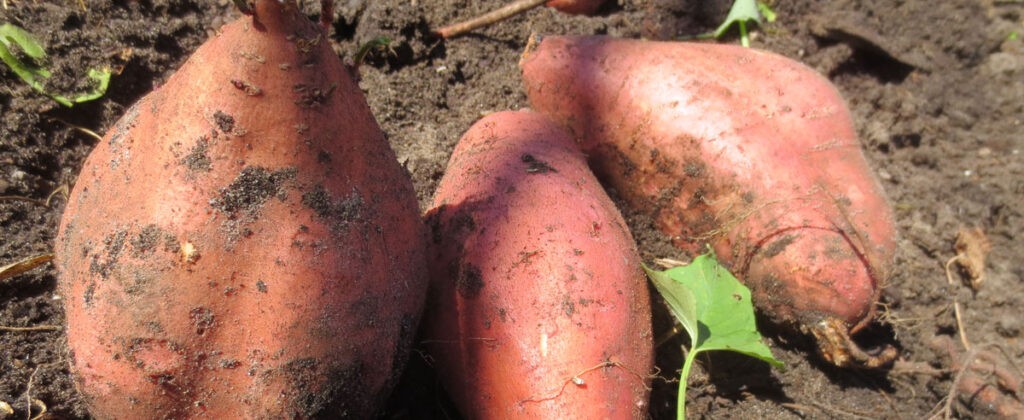Updated:February28,2024 Here at NHG, we know you love pretty blooms that are easy to plant,…
Growing Sweet Potatoes in Texas Gardens

Luckily, Sweet Potatoes Are Easy to Grow!
Sweet potatoes pack a wallop of nutrition in their large, dense tuberous roots. While the varieties bred for the edible roots can vary from purple-red to pale creamy yellow, the more orange-fleshed varieties are considered the sweetest, with tubers that bake into a moist, flavorful meal or delicately sweet, crispy fries.

About the Sweet Potato
Sweet potatoes, Ipomoea batatas, are only very distantly related to the common potato, Solanum tuberosum. While common potatoes are the cousins of tomatoes and peppers within the nightshade family, Solanaceae, sweet potatoes are in the morning glory family, Convolvulaceae—and if you’ve ever seen your edible or ornamental sweet potatoes bloom, you’ve likely noticed how their little trumpet-shaped flowers look just like morning glories.
While the common name ‘Yam’ is applied to sweet potatoes in some parts of the world, the true yam is actually of the genus Dioscorea; the plant is a monocot, and it is completely unrelated.
Ornamental varieties have been hybridized for dramatic chartreuse (‘Marguerite’), tricolor or purple-black (‘Blackie’) foliage, and their tubers are considered to be of poor quality for eating (although they will form them).
When to Plant Sweet Potatoes in Texas
Both edible and ornamental varieties are well-suited to summer heat; in fact, they tend to get off to a poor start if planted too early while temps are cool and the weather is wetter. For full infromation on when to plant your sweet potatoes you can refer to our comprehensive seasonal planting guide for Texas. They’re not terribly picky about soil, although good drainage is absolutely necessary, and amending with compost is appreciated. The slips are fairly quick to establish, and with supplemental irrigation, quick to grow and spread.
Harvesting Your Sweet Potatoes
 Sweet potatoes are well-suited to north Texas’ hot summers, and NHG stocks five reliable varieties from which you can choose. ‘Beauregard’ is a favorite with high yields of sweet, elongated tubers that have extra orange flesh. ‘Red Japanese’ is a variety with pale, creamy flesh that’s drier than the orange-fleshed varieties and was bred for Asian vegetable markets.
Sweet potatoes are well-suited to north Texas’ hot summers, and NHG stocks five reliable varieties from which you can choose. ‘Beauregard’ is a favorite with high yields of sweet, elongated tubers that have extra orange flesh. ‘Red Japanese’ is a variety with pale, creamy flesh that’s drier than the orange-fleshed varieties and was bred for Asian vegetable markets.
‘Nancy Hall’ is an old-time favorite with ivory, pale orange flesh. It’s particularly valued as a long-storing variety whose flavor improves after curing. ‘Centennial’ is a common favorite with deep, carrot-orange flesh. It’s fast to grow, producing smaller “baby bakers” after about 90 days. It’s a favorite variety for baking.

Each of these varieties has it’s own benefits, and they’re all nutritious–especially the orange varieties, which are extra-rich in beta carotene (the organic pigment responsible for their orange color). As so many of us make an effort to ‘eat the rainbow’ and diversify our diets with healthy vegetables, sweet potatoes merit renewed attention for their ease of cultivation and high nutrient value. Make room to grow some in your garden this year; you’ll be glad you did!

